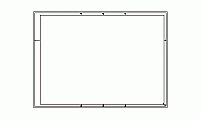CAD Blocks categories
 3D models
3D models home furniture
home furniture sanitary ware - bathrooms
sanitary ware - bathrooms professional equipment
professional equipment doors and windows
doors and windows people and animals
people and animals plants and trees
plants and trees vehicles - transports
vehicles - transports architectural details
architectural details mechanical - electrical
mechanical - electrical urban planning - civil works
urban planning - civil works safety health construction
safety health construction accessible design
accessible design drawing sheet
drawing sheet signals
signals construction machinery
construction machinery accessories and objects
accessories and objects maps and street maps
maps and street maps
ANSI Drawing Sheet Sizes in CAD Format

size: 63 kb
category: drawing sheets and presentations
description: standard ANSI drawing sheet sizes (A, B, C, D, E), organized according to the ASME Y14.1 dimensions.
file extension: .dwg CAD - AutoCAD software
ASME Y14.1 Standardized Dimensions for ANSI Sheets
ANSI Sheet Sizes Defined by ASME Y14.1 Standards
The ANSI sheet sizes are specified by the ASME Y14.1 standard, ensuring consistency and precision in technical documentation. The sizes include ANSI A (8.5" x 11"), ANSI B (11" x 17"), ANSI C (17" x 22"), ANSI D (22" x 34"), and ANSI E (34" x 44"). These formats were designed to meet the needs of various industries, facilitating seamless communication and reproduction of engineering and architectural projects.
What is ANSI and Where is it Used?
The American National Standards Institute (ANSI) is an organization that develops and publishes standards to ensure uniformity and quality across industries. The goal of ANSI standards is to create universally accepted guidelines for technical documents, products, and processes. While primarily used in the United States, ANSI standards influence other countries, particularly in North America, promoting cross-border consistency in engineering and design.
Why Were Standardized Drawing Sheet Sizes Created?
Standardized drawing sheet sizes, like those defined by ANSI ASME Y14.1, were developed to address inconsistencies in technical documentation. By defining standard sizes, organizations could streamline production processes, reduce material waste, and improve clarity in communication across engineering, construction, and design industries. These standards also ensure that drawings fit well into storage systems and reproduction technologies, such as printers and scanners.
Fields Where Standard Sheet Sizes are Used
Standardized drawing sheet sizes are essential in fields such as architecture, engineering, and construction. For instance, architects often use ANSI C, D, and E sizes for building plans, while engineers rely on ANSI B for detailed schematics. These sizes ensure compatibility with standard printing devices and ease of handling for project stakeholders, from designers to construction managers.
Are Standard Sheet Sizes Still Relevant in CAD Design?
In the digital age, the use of CAD software has transformed technical documentation. While traditional sheet sizes like ANSI A to E are still used for printing and archiving, digital workflows often allow for custom layouts optimized for screens. To use standard ANSI sizes in CAD programs, users can configure their drawing templates with predefined dimensions or customize title blocks for specific project requirements. Despite advancements, these formats remain integral for ensuring continuity between digital and printed documentation.


















